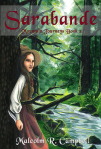Malcolm R. Campbell's Blog, page 193
April 4, 2016
Haints, Plate-Eyes and Demons, oh my
Frankly, I don’t like reading specific directions for summoning evil spirits because I’m afraid I’ll accidentally think them or recite them and suddenly a hideous monster will appear.
 From hoodoo to witchcraft to high magic, the lore is filled with cautions about the dangers of summoning bad stuff because unless you know what you’re doing, the bad stuff will come after you. This would be kind of like purchasing a rabid dog to keep traveling salesmen away from your door. The odds seem high that the dog will attack you first.
From hoodoo to witchcraft to high magic, the lore is filled with cautions about the dangers of summoning bad stuff because unless you know what you’re doing, the bad stuff will come after you. This would be kind of like purchasing a rabid dog to keep traveling salesmen away from your door. The odds seem high that the dog will attack you first.
Another reason I don’t like reading specific directions for summoning evil spirits is the feds. They probably track this stuff and the last thing I need is the NSA telling the FBI that I used the search terms “black arts conjure oil” or “hoodoo demon-calling spell” enough times for it “to be a problem” as opposed to looking for crossword clues.
Writers often talk about stuff like this. We worry about doing research about how to kill people, make bombs, mix deadly and untraceable poisons, and making pacts with the devil. The people who have that kind of history on their computers usually tern out to be serial killers or the kind of nut cases who join ISIS and saying “I’m just writing a book” probably won’t cut it when the cops arrive.
I didn’t worry about this when I was writing Conjure Woman’s Cat because for that book, I was looking up good spells, good charms, and how to reverse jinxes. But in the sequel, my good conjure woman is combating a black arts root doctor and so I have to know more about that side of the business for her to be able to speculate about what he’s doing and how.
Since I try to make the spells and uses of herbs as realistic as possible within the world of conjure, I don’t feel right just making it up. Suffice it to say, the curses I’ve found aren’t going into the sequel verbatim. For one thing, I have to find a spell or recipe in multiple places before I’ll trust that it’s more than the imaginings of one resource. For another, what if the thing works as advertised? I don’t need to see on CNN that people are using my book to summon demons to go after their spouses’ lovers or to disrupt law-abiding governments (if any). So, everything has to be blurred around the edges: exact enough to make a real conjure woman nod in agreement but inexact enough to your child, spouse or neighborhood crook can’t use it.
By the way, plate-eyes aren’t seen very much any more, but generally they’re unpleasant, what with their glowing eyes the size of plates. If one bothers you, you can get rid of it with anything that smells bad. I’m pretty sure I’m not going to use any plate-eyes in the sequel to Conjure Woman’s Cat because nobody seems to know how to contact one of them. Haints, well, they’re okay, but they usually have their own agendas.
Demons, though, they’re looking pretty good, figuratively speaking, because they’re easier to summon that most people think and fewer people are going to question whether the author has used the right technique or the wrong technique to call them.
When the book comes out, I promise it won’t contain the exact technique for calling a demon. It will be close enough to make the book slightly dangerous. But that’s what readers want.
–Malcolm
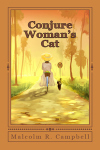 Malcolm R. Campbell is the author of “Conjure Woman’s Cat” and a batch of paranormal Kindle short stories.
Malcolm R. Campbell is the author of “Conjure Woman’s Cat” and a batch of paranormal Kindle short stories.


April 1, 2016
Words you never publish might change the world
Those words that might change the world: perhaps you don’t know you’ve written them. You wrote them in a letter that changed another person’s life, and then others and countless others, and you never knew.
 Those words that might change the world: perhaps you wrote them in your diary. You didn’t know what they meant until you wrote them and when you knew, you were changed and the ways you changed impacted what you wrote and published after that.
Those words that might change the world: perhaps you wrote them in your diary. You didn’t know what they meant until you wrote them and when you knew, you were changed and the ways you changed impacted what you wrote and published after that.
Those words that might change the world: perhaps they’re within a poem, a short story or a novel that never found a publisher. Even if none of your heirs find and publish those words and change the world long after you’re gone, they exist now and are part of your life, a life that would have gone down different roads without those words hidden away in a drawer.
You draw strength from the words you write because every word you write changes you into a person who is different than the one who sat down to write. Your strengths ripple outward and impact people who never see the words that served as a catalyst. Who you are now is always partly determined by the growth you achieved through writing words you may never publish.
The words you write are never wasted even if you throw them away. They are never quite gone from you even if your conscious mind cannot recall them. They are like a continuing breath, unseen but life altering and life giving.
You have cast a spell on yourself, enchanted yourself, discovered heretofore unknown dimensions of yourself, and from such things, there’s no return.
Since you cannot return, you will write other words that are impacted by your older words, you will say something wondrous to a stranger that you meet because the you who wrote those words walks down different streets with influences you may never see, you will wave to a man or woman on the street who will be changed, perhaps ever so slightly, by that wave or the smile behind it even though s/he will never know of the long lost words that brought about that moment.
This is the power of words that exist but remain hidden while their energy turns the world on its axis and casts devils into the sea.
–Malcolm


March 31, 2016
Inanna’s mythic heroine’s journey
from the archives
“The world’s first love story, two thousand years older than the Bible—tender, erotic, shocking, and compassionate—is more than a momentary entertainment. It is a sacred story that has the intention of bringing its audience to a new spiritual place. With Inanna, we enter the place of exploration: the place where not all energies have been tamed or ordered.” – Diane Volkstein in “Inanna, the Queen of Heaven and Earth: her Stories and Hymns from Sumer”

Inanna, as envisioned by nikkirtw123 on Photobucket is strikingly close to my vision of Sarabande as I wrote the novel.
As an author, I view my characters through a high-powered microscope and present the results of what I see as part of my stories. I will put you into the characters’ shoes if I can because—as Diana Volkstein writes—this is where the energies haven’t been tamed or ordered.
In an older novel, I described that place like this: “He knew him at the binary level where the line between matter and energy is barely discernible and often non-existent: Where urges pull at their chains, where drives push dumbly and drip sweat, where instincts race unchecked, where a horrifying sadness lies buried, where a raw pulse drums a cadence for the primitive rites of changing seasons, where white-hot impulses leap synapses in a shower of elemental fire.”
I wanted a similar, up-close focus in my heroine’s journey novel Sarabande. So, for the story of a woman seeking wisdom and wholeness, I could think of no better model than the myth of Inanna, a graphic dramatization of a woman’s inner journey to find herself outside the traps and trappings of a masculine world that has–as Sylvia Brinton Perera (“Descent to the Goddess”) wrote–forced the binary level of feminine power into dormancy for 5,000 years.
Or, as the late Adrienne Rich said, “The woman I needed to call my mother was silenced before I was born.”
Sarabande’s Heroine’s Journey
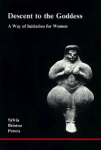
The journey in “real life”
In today’s terms, Sarabande was a tomboy. She was an expert with a knife, bow and arrow, a fishing pole, and everything she needed to know to survive in the wilderness. She learned all this from her father because her her mother believed women should only learn to keep a good home and not question society’s norms for women. However, Sarabande will never truly become herself as long as she is a disciple of either her late warrior father or her misguided, preachy mother. She is being taunted by a ghost that she must approach face to face in the ghost’s world.
Early on in her quest to rid herself of the ghost of her dead sister Dryad, Sarabande learns to see the world at a binary level: The lake, surrounding mountains and the cloud-draped sky broke apart into millions of colored specks. Sarabande leaned against Sikimí, even though he was no longer solid, and saw that her own light-pink hand was not solid either. In spite of her sudden dizziness, she did not fall. In fact, when her fingertips touched Sikimí’s side, a swarm of pink specks flew, like bees, into the permeable yellow gold of the horse, and when they did, their color changed to match the specks in their new environment.
But she doesn’t know what it means. So it is, that her quest to find and confront her sister follows the pattern of Inanna’s Heroine’s journey to confront her sister Eriskigal, Goddess of the Underworld. The underworld, in this case, is not the world of mobs and crime or “hell” in the Christian view, but the more dangerous world of the unconscious. Like Inanna, Sarabande will be broken, shamed and close to death before she learns who she is.
This is the heroine’s journey, to be buried in mother earth like a seed where she will be reborn with the spring into a new creation that finally has the freedom to follow the original injunctions of her destiny and her gender.
–Malcolm
The Kindle edition of “Sarabande” is on sale today (March 31, 2016) for 99¢.


March 29, 2016
Is writer-to-writer networking just another way to avoid actually writing?
Writers spend a lot of time not writing. Not writing includes marketing, promotional stuff, platform building, blog posts and other ways of establishing a writer’s online presence and calling attention to the books. It also includes book signings, readings, appearing on panels and running a booth at a book fair.

Maybe this works for screen writing teams, but it doesn’t look good for novelists.
The headline for this posts tells you I’m skeptical about, say, slumber parties for writers or retreats where writers show each other what they’re going and discuss it and the whole concept of write-ins.
A write-in, as I learned in an Indies Unlimited post (Do You Need to Be Closer to More Writers?) this morning is (basically) a bunch of writers with laptops assembled around a big table all typing diligently into a DOCX file some meaningful scenes in their work in progress.
WTF
Okay, for those who love these things and come home with some work accomplished, go for it. But this sounds more like an excuse to sit around and shoot the breeze and have a few beers rather than doing serious work. As far as I know the whole shebang isn’t like synchronized swimming and other similar events at the Olympics. To work, this is going to require discipline. Every time one of the writers sighs, laughs, or utters a string of profanity, everything’s going to stop and people will talk about that.
In my world, a writer goes into a cave, works on his or her book, and when it’s done, s/he comes out and gives it to an editor who cleans up the parts of it that are a mess. The whole concept of having beta readers looking over a writer’s shoulder during this process gives me the willies. Next thing, there will be focus groups to decide whether, say, allowing Bob to have sex with Jane will lose readers or gain readers.
Hemingway once told writers to be careful about talking their novel/story away. By this he meant, sitting down with another writer and telling them the plot of a story-to-be, getting into a discussion about it, and then suddenly losing the whole thing. That fits my concept of writing: nobody sees anything until it’s done. No write-ins, no beta readers, no family inputs, not posting scenes on bulletin boards for critiques, no sharing.
All that stuff leads me away from the process of creating a story. It sounds too much like a committee approach or maybe a screwing-around-drinking-coffee-rather-than-actually-writing approach.
That’s my two cents for today.
–Malcolm
Malcolm R. Campbell is the author of various things which are available in various places for various prices.


March 26, 2016
Crank down in Florida thinks he can make ice as good as God Almighty
 Dr. John Gorrie of Apalachicola Florida was a pioneer in the development of mechanical refrigeration in the 1840s. He saw cool air, whether from ice or from the lowering of the temperature in a room, as a medical means of combating such diseases as yellow fever and malaria. However, as a “Smithsonian” article about him suggests, he received a chilly reception, lost backers, and was never able to pursue the equipment’s development based on his early patent.
Dr. John Gorrie of Apalachicola Florida was a pioneer in the development of mechanical refrigeration in the 1840s. He saw cool air, whether from ice or from the lowering of the temperature in a room, as a medical means of combating such diseases as yellow fever and malaria. However, as a “Smithsonian” article about him suggests, he received a chilly reception, lost backers, and was never able to pursue the equipment’s development based on his early patent.
I first saw the John Gorrie museum, a Florida State Park, in Apalachicola when it opened in 1958. It is one of the treasures of visiting the “other Florida” or “the forgotten coast” in the panhandle by following U.S. Highway 98. Now, we take the creation of ice for granted and–except for days when we’re waiting for the repairman–we rely our window air conditioners and central HVAC systems.
However, the creation of ice by man was thought by some during Gorrie’s time as an affront to nature as “Smithsonian” noted in its July 2002 article: “Gorrie, who used air as the working gas in his machine, took his idea north to the Cincinnati Iron Works, which created a model for public demonstration. But the notion that humans could create ice bordered on blasphemy. In the New York Globe, one writer complained of a ‘crank’ down in Florida ‘that thinks he can make ice by his machine as good as God Almighty.'”
 An opposing view appears on the state park’s website: “Not long after the death of Dr. Gorrie in 1855, famed botanist and physician Alvan Wentworth Chapman commented to celebrated botanist Asa Gray, ‘Gray, there is the grave of a man we recognize as superior to all of us.’ The technology needed to discover the cure for yellow fever still does not exist. Gorrie’s valiant attempt inadvertently created a machine and theory that changed the world forever. The John Gorrie Museum State Park reveals this remarkable and compassionate man and shows the amazing machine he created.”
An opposing view appears on the state park’s website: “Not long after the death of Dr. Gorrie in 1855, famed botanist and physician Alvan Wentworth Chapman commented to celebrated botanist Asa Gray, ‘Gray, there is the grave of a man we recognize as superior to all of us.’ The technology needed to discover the cure for yellow fever still does not exist. Gorrie’s valiant attempt inadvertently created a machine and theory that changed the world forever. The John Gorrie Museum State Park reveals this remarkable and compassionate man and shows the amazing machine he created.”
While the original Gorrie ice making machine is in the Smithsonian Institution, you can see a replica of it while visiting the Gorrie Museum on 6th Street in Apalachicola, one block off U.S. Highway 98.
For more information on Dr. Gorrie, see: Explore Southern History
–Malcolm
Malcolm R. Campbell grew up in the Florida Panhandle and has written fiction such as “Conjure Woman’s Cat” set in the areas he explored many years ago.


March 24, 2016
‘Voodoo & Hoodoo’ by Jim Haskins
“As a child growing up in a small town in Alabama, I shared the experience of most southern-born black children as well as many northern black children whose families migrated from, or maintained close ties with, the South. We were aware at an early age that there were more forces to contend with than met the eye. A person’s very neighbors, thought outwardly friendly, might be plotting against him, ‘laying a trick’ on him. But they didn’t perform the actual trick themselves; they had neither the power nor the knowledge. Instead, they went to the local hoodoo doctor or root worker.”
– Jim Haskins, in the book’s introduction.
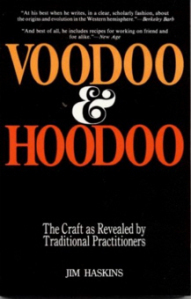 First published in 1978 and available as a used book on Amazon, Jim Haskins’ Voodoo & Hoodoo: The Traditional Craft as Revealed Traditional Practitioners is a worthwhile introduction to southern folk magic. One Amazon reviewer says that the author didn’t want the word “Voodoo” in the title, but that this was added by the publisher to ramp up sales. The term is misleading because the book is about herbs, root doctors and practices that have little to do with the Voodoo religion.
First published in 1978 and available as a used book on Amazon, Jim Haskins’ Voodoo & Hoodoo: The Traditional Craft as Revealed Traditional Practitioners is a worthwhile introduction to southern folk magic. One Amazon reviewer says that the author didn’t want the word “Voodoo” in the title, but that this was added by the publisher to ramp up sales. The term is misleading because the book is about herbs, root doctors and practices that have little to do with the Voodoo religion.
When I was writing my novella Conjure Woman’s Cat, I found this book to be a credible introduction, especially for those of us who grew up in the South around the edges of the practices and point of view Haskins describes. The quotation at the beginning of this post is typical of the kind of thing many of us (white and black) heard when we were young, but often had a hard time finding anyone who would tell us what it was all about.
While the book includes spells and recipes, they aren’t the strong point: the value here is the ambiance and sense of the craft one gets from the practitioners themselves.
You’ll find plenty of spells and recipes and herbal information on the Internet and in books such as Hoodoo Herb and Root Magic and The Black Folder both by cat yronwode. Or, you can look at hoodoo blogs such as Spiritual Information for more details about methods and practices. As an author, I needed a starting point and Haskins’ book was a good one for that. If you’re researching hoodoo, or simply interested in learning more about it as a component of southern culture, the book will also give you a starting point.
Frankly, I do not like authors who look up practices (spiritual, cultural, or ethnic) on, say, Wikipedia, grab a few basics, and then head straight for books with spells. Doing this is dishonest because it paints an inaccurate, Hollywood-style picture of something real and twists it into something made to look like fantasy. J. K. Rowling recently got into trouble with American Indian nations for taking bits and pieces of their beliefs and using them out of context in her new writing on the Pottermore site. This practice is often called appropriation.
I prefer appreciation when it comes to another culture and its spiritual and folk magic practices. With appreciation, we’re telling something true–even in a novel–because we’re keeping our references to the art and craft of the people as correct and in context as we can make them. In order to do this, one has to immerse himself or herself into the world and world view of your fictional hoodoo (or other magical, cultural or spiritual) practitioners long before looking for, say, specific spells/charms/herbs that fit into the plot of one’s fiction.
The resulting book, whether it’s in the magical realism genre or labeled by Amazon as fantasy, is reality based in the same sense that a book with a protestant minister or Catholic priest is reality based because it starts with characters whose beliefs are part of a real system.
When it comes to hoodoo, Jim Haskins’ overview of the craft and the culture it came from was a good place for me to start.
–Malcolm
 Conjure Woman’s Cat, from Florida publisher Thomas-Jacob, is available in e-book and paperback editions–and coming soon as an audio book. It’s set in the world where I grew up, the places I explored when I sneaked away from the house, and focuses on the racism I didn’t understand then or now.
Conjure Woman’s Cat, from Florida publisher Thomas-Jacob, is available in e-book and paperback editions–and coming soon as an audio book. It’s set in the world where I grew up, the places I explored when I sneaked away from the house, and focuses on the racism I didn’t understand then or now.


March 21, 2016
Faerie tale in a mirror
Once upon a time—when time was more speculative than it is today—a king and queen had no children. The lords and ladies at court watched the night skies for signs and the townspeople from shipwright to innkeeper offered prayers and charms to the realm’s gods because the court and castle were dour, grey and unhappy indeed.
The king and queen seldom ventured outside the castle walls because nature’s cycles were rich and profligate. Across the parklands and throughout the forests, bluebells, roe deer, and red kites were blessed with young past human understanding.
The royal couple consulted astrologers, crossroads spirits, and the legendary faerie in the great forest. They carried talismans, drank teas, and chanted strange combinations of awkward incantations during the blue hours and holy days. Yet no answers came.
The queen considered herself sorely lacking as the barren years grew in number like stacked-up like rushes grown foul with use. The king felt cursed for the frivolities of his youth. Desperate, the couple went to a solitary goodwife and upon the winter solstice they drank together her bitter coction of herbs prepared over an unnatural fire.
So it begins. You’ve been there before…a girl child is born…she’s a fetching one…but a faerie is inadvertently slighted…a curse is pronounced…ultimately she sleeps for one hundred years waiting for the kiss that will wake her up into the world.
What handsome prince wouldn’t want to kiss a young woman so beautiful, so pure. . .

But wait!
In “Waking Plain,” my new Kindle faerie tale, the sleeper is a young prince.
They say he’s as dull as dishwater, and that is kind.
The castle is a wonderment as always. So, too, the faeries and their magic. Even the great forest surrounding the wonderment of a castle is enchanted with four-legged animals and winged creatures and flowers and trees and sunshine that are grand beyond the understanding of everyday men and women.
But if the sleeper isn’t beautiful, who will kiss him? Perhaps it’s kinder to the young man–not to mention, the world itself–to let him sleep.
I don’t mean to imply that the classic tale of “Sleeping Beauty” is sexist, only to say that it’s more realistic to ponder how it would be for an everyday kind of guy–you know, the one who would be the last one chosen for a team during recess–to wait for eternity, if not longer, for the woman of his nightmares to kiss him and re-awaken him for all to see.
They would prefer not to see him, of course, but they might, just maybe, in this faerie tale in a mirror.
–Malcolm
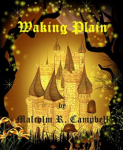 Inasmuch as “Waking Plain” is a Kindle faerie tale (or as Amazon calls it, a “fairy tale”), that is where you will find it, and not for a who’s-fooling-whom 99¢ but for an entire $1.00. That extra penny is your payment to the faerie world for allowing this story to be told.
Inasmuch as “Waking Plain” is a Kindle faerie tale (or as Amazon calls it, a “fairy tale”), that is where you will find it, and not for a who’s-fooling-whom 99¢ but for an entire $1.00. That extra penny is your payment to the faerie world for allowing this story to be told.


March 18, 2016
Springtime means trying to start the lawn mower
During the cold, wet, seemingly endless winter when more people than not are discontent, dreams focus on springtime and sitting in the sun and leaving the windows open.

First sign of lawn mowing season.
I think about the lawn mower.
Later on I think about hot Georgia afternoons and start looking for the first signs of autumn’s more civilized weather. After my wife and I finished planting six more flowering trees, we wandered over to the riding mower out of curiosity.
It started on the first try, bless its heart.
Now that we’ve started the lawn mower, the grass has suddenly gotten the idea that it should grow like there’s no tomorrow. I know there’s going to be a tomorrow: I saw it in the weather forecast which said, “Warmer temps just perfect for lawn mowing.”
Now the grass looks like we’ve never bothered to mow it and in a rural area where people often use combines to cut trim their front yards, it gets kind of hard to go outside during the day time in the grass is tall enough to bale.
Naturally all the gasoline cans were empty. They’re full now and the car smells like the BP station.
I’m almost ready to sit on my riding mower with an ice bold beer in the cup holder and dream of snow and old man winter.
–Malcolm
 Malcolm R. Campbell’s navy novel “At Sea” is free on Kindle March 18, 19 and 20.
Malcolm R. Campbell’s navy novel “At Sea” is free on Kindle March 18, 19 and 20.


March 17, 2016
Vietnam Navy Novel Free on Kindle for Three Days
My Vietnam War navy novel At Sea will be free on Kindle March 18-20, 2016.
 Description: Even though he wanted to dodge the draft in Canada or Sweden, David Ward joined the navy during the Vietnam War. He ended up on an aircraft carrier. Unlike the pilots, he couldn’t say he went in harm’s way unless he counted the baggage he carried with him. As it turned out, those back home were more dangerous than enemy fire.
Description: Even though he wanted to dodge the draft in Canada or Sweden, David Ward joined the navy during the Vietnam War. He ended up on an aircraft carrier. Unlike the pilots, he couldn’t say he went in harm’s way unless he counted the baggage he carried with him. As it turned out, those back home were more dangerous than enemy fire.
Here’s a short excerpt to tempt you out to Amazon. . .
David stood on the back porch on a spring evening listening to the slow sweet rising and falling howl of a wolf calling her pups while the wind stilled and the dark lavender lupine flowers disappeared into the gathering twilight. Behind him, the house was empty, his dinner long gone cold on the kitchen table along with the passionate Sparrow singing his chanson favorite “La Vie en Rose” again and again, and rather than stare at the letter in the silent company of canisters and chrome appliances, he brought the telephone and pinot noir outside where the world was less closed in on itself.
At the end of the long cord, he dialed her number, wondering—while the wolf pups yipped back at their mother—if her hello would still sound like her hello.
“Davey, how nice to hear your voice. I also hear wolves. Where are you?”
“On the porch looking down toward the box elders and the creek.”
“Don’t remind me. It hurts too much.”
“How are you?”

T he book was inspired by my time on board the the USS Ranger.
“Fine. I knew you would call. While practicing my flute this morning, I found myself playing a song we once knew.”
“I’ve lost myself to the war,” he said. “The letter arrived today. I report in July.”
“Davey, no. What do your parents say?”
“Not to rock the boat.”
“I hoped you went to Sweden with Brita. Then I heard the wolves.”
“I could never come home from Sweden.”
“If you die in Vietnam, I’ll forget you. If you survive, you’ll forget yourself. Either way, the vine may kill the elm.”
“You’re cold,” he said, “and dragging out old symbolism of fruitful grapes smothering their supporting tree.”
“Then stand quiet with me again.”
The wolves were silent. He heard her breath and her heart. The first stars were out. When she was at the ranch four years ago, she said, “Night is liquid magic; we’re stirred together. You’ve taken me beyond myself, higher than the wolf trail stars, and what we have of each other, we own.”
In the great quiet, he wept for the parts of himself that were no longer his.
“David, the baby’s crying. I’ve got to go.”
“Unfair! But I love you, Anne.”

USS Ranger at sea in 1968 – US Navy Photo, cleared for publication
“No doubt,” she said, hanging up and extinguishing the moon’s pure light.
He carried the wine bottle up to the chokecherry tree, sat beneath white flowers and watched the night where he once watched it with her.
She knows I’m here, he thought, because she knows me well. She despises me, too, because she believes some places are sacred.
He got an axe and chopped down the tree. It was neither the best thing nor the worst thing he’d ever done, but it was close.
–
If you’re a Kindle Unlimited subscriber, you can always read the book for free through Amazon’s program. If you’re not a KU subscriber, now is a great time to download a novel about sailors and bar girls and mountain climbing and a young man wrestling with his conscience about military service.
I hope you enjoy the story.
–Malcolm


March 16, 2016
Two organizations helping conscientious objectors
When I became a conscientious objector during the Vietnam War, the primary issue was conscription. The secondary issue was the concept of an unjust or unnecessary war. The draft ended in 1973, but the concept of needless wars did not.
 Today, many who are willing to join the military to protect the country, become uncomfortable–as many did during the Vietnam War–with combat and casualties which appear to serve no viable purpose. In recent years, people have asked the same kinds of questions about Iraq and Afghanistan that were once asked about Vietnam: should we be there?
Today, many who are willing to join the military to protect the country, become uncomfortable–as many did during the Vietnam War–with combat and casualties which appear to serve no viable purpose. In recent years, people have asked the same kinds of questions about Iraq and Afghanistan that were once asked about Vietnam: should we be there?
In the 1960s, many of us sought practical help from the Central Committee for Conscientious Objectors (CCCO) and their handbook which outlined how to apply for a CO status and outlined the kinds of questions one would be asked if they did. This group is more or less no longer active.
Today, if one is against all wars and rejects even non-combatant participation, then (if you’re a man) you still have to register with the Selective Service Commission. However, as long as enlistment is voluntary, there are fewer issues to face unless you disagree with the concept of registration.
 If you join the military and consider conscientious objection due to the role you’re being asked to play, two organizations can help you sort through what (if anything) you can legally do. You will see on their sites routes you can take along with information about such issues as the so-called endless war, the morality of drone strikes, and even the militarization of police forces.
If you join the military and consider conscientious objection due to the role you’re being asked to play, two organizations can help you sort through what (if anything) you can legally do. You will see on their sites routes you can take along with information about such issues as the so-called endless war, the morality of drone strikes, and even the militarization of police forces.
The Center on Conscience & War is a non-profit organization that advocates for the rights of conscience, opposes military conscription, and serves all conscientious objectors to war. Founded in 1940 as the National Interreligious Service Board for Conscientious Objectors, CCW can help you find alternative service to the military and/or help you through the maze of regulations should you wish yo file as a CO.
The American Friends Service Committee, where many of us also went for help during the Vietnam War, is an active organization today with multiple programs. Their programs seem more extensive than those of CCW, because they address such things as the refugee problem and the military budget.
Today’s conscientious objectors hope to see rights and procedures codified into law rather than remaining dependent on the regulations of military branches where they can be and have been suspended for various reasons. Larger issues, such as the demilitarization of police forces, the legality of drone attacks, and solving refugee problems by addressing basic issues causing conflict rather than looking at refugees as charity cases are in my view outside the conscientious objector framework. (That is not to say that we shouldn’t address them.)
I wrestled with the problems–and stigma–of becoming a CO during the 1960s and think that many of the same issues are with us today even without the draft.
The issue is by no means settled and the stigma is by no means gone.
–Malcolm
 Malcolm R. Campbell is the author of “At Sea,” a novel about a conscientious objector during the Vietnam War.
Malcolm R. Campbell is the author of “At Sea,” a novel about a conscientious objector during the Vietnam War.



